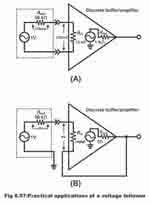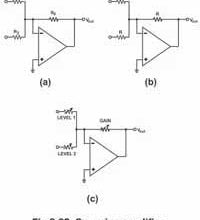LM358 IC Pin Configuration, Working, LM358 Circuit Examples
Table of Contents
Description:
The LM358 contains two independent high gain operational amplifiers, low power, dual channel op-amp, high gain with internal frequency compensation. Single power supply will be required to operate both op-amps in LM358. We can also use a split power supply. The device has low power supply voltage.
LM358 IC can also be used as transducer standard operational amplifier and it is suitable for our needs. It can handle voltage from 3V to 32V DC supply and current up to 20mA per channel. It consists of 8 pins which contains two operational amplifiers.
In this IC we have two operational amplifier which can we use as a comparator. LM- The low power drain also makes the LM358 a good choice for battery operation. Generally we obtain signal from sensor are usually have small rating. We cannot do anything with this rating for example we obtain 0.3V from sensor. By using 0.3V we cannot ON/OFF led or relay. The LM-358 IC get signal from the sensor and compare to the reference voltage. Then this IC will decide whether the voltage is greater or less than reference voltage by giving output high or low.
The LM358 is a versatile uses it can be used as comparator to compare different signals, amplifying signals from a variety of transducers or sensors to dc gain blocks or any op-amp function.
Amazon Purchase Links:
Other Tools and Components:
Super Starter kit for Beginners
PCB small portable drill machines
*Please Note: These are affiliate links. I may make a commission if you buy the components through these links. I would appreciate your support in this way!
Pin configuration of LM358:
| Pin Number | Pin Name | Description |
| 1 | OUTPUT 1 | This pin is the output of first operational amplifier |
| 2 | INPUT 1 – | This pin is the inverting input of first op-amp |
| 3 | INPUT 1 + | This pin is the non-inverting input of first op-amp |
| 4 | GND or | This ground or negative supply to op-amp |
| 5 | INPUT 2 + | This pin is the non-inverting input of second op-amp |
| 6 | INPUT 2 – | This pin is the inverting input of second op-amp |
| 7 | OUTPUT 2 | This pin is the output of the second op-amp |
| 8 | This pin is the positive voltage supply to both op-amp |
Operational amplifier:
An Operational Amplifier, or op-amp for short, is fundamentally a DC coupled high gain voltage amplifying device they are ideally designed for signal conditioning, DC amplification, filtering and to be used with external feedback components such as capacitors and resistors between its output and input terminals.
The op-amp perform different function depending upon its feedback configuration whether it resistive, capacitive or both on the bases of this it can be used differential amplifier, integrator or summer.
Non-inverting input:
The operational amplifier non-inverting input is marked by a “+” sign on the circuit diagram in LM-358 the non-inverting input is pin number 3. It is found that a positive voltage applied to the non-inverting input then it will not be change and it will produce a positive swing at the output. If a changing waveform, such as a sine wave is applied to the non-inverting input such as pin number 3 in LM-358, then it will appear in the same sense at the output. It has not been inverted.
Inverting input:
The operational amplifier inverting input is marked by a “-” sign on the circuit diagram in LM-358 the inverting input is pin number 2.
A negative voltage swing will be produce when positive a positive voltage is applied at the inverting input. Thus a sine was applied to the inverting input, will appear inverted at the output.
LM358 Rating:
If the rating of the LM-358 exceed from these values it will be damage it will work on the rating given below:
- Integrated with two Op-Amps in a single package
- Wide power supply Range
- Singe supply – 3V to 32V
- Dual supply – ±1.5V to ±16V
- Input differential voltage range ±32
- Low Supply current – 700uA
- Input common mode voltage range -0.3 to 32
- Single supply for two op-amps enables reliable operation
- Junction temperature 150˚C
- Operating ambient temperature – 0˚C to 70˚C
- Storage temperature range – 65˚C to 150˚C
- Soldering pin temperature – 260 ˚C (for 10 seconds – prescribed)
- Short circuit protected outputs
- Available packages: TO-99, CDIP, DSBGA, SOIC, PDIP, DSBGA
Advantages of LM358:
LM-358 has different advantages, a few of which are given below.
- There is no need separate supply to the op-amp
- LM-358 is Compatibility with all forms of logic.
- Two Op-amps, compensated internally we can use both op-amp at a time or if we need only one op-amp we can used it .
- Power drain suitable for battery operation.
- Removes the necessity of dual supplies
- Permits direct sensing close to GND & VOUT
- DC gain block due to which it has minimum interference to RF signals
- General signal conditioning because it can be used as comparator it compare two signals
- Transducer amplifiers it can convert sound signals into electrical signals
- General signal amplification it amplify signal
- Active filters because it remove noise from the signal
- Operational amplifier circuits.
- Current loop transmitters for 4 to 20mA.
- Conventional op-amp circuits
- It can be used as Integrator, Summer, Differentiator, adder, Voltage follower, etc.,
- Power supplies and mobile chargers
- Motor control: AC induction, brushless DC, brushed DC high-voltage, low-voltage, permanent magnet, and stepper motor
- Desktop PC and motherboard contains LM-358
- Indoor and outdoor air conditioners
- Washers, dryers, and refrigerators
Replacement / Equivalent / Other Part Numbers:
LM2904, LM258, LM324 may also be used as a replacement for LM 358 if space is not a problem.
Single Supply and Dual Operational Amplifiers:
These dual operational amplifiers feature low power drain, a common mode input voltage range means it give amplification to the signal that appear on the common extending to ground/VEE, and single supply or split supply operation. The LM358 series contain two operational amplifier is equivalent to one−half of an LM324 which contains four operational amplifiers.
Features
- Single and Split Supply Operation
- Short Circuit Protected Outputs
- Internally Compensated
- True Differential Input Stage
- Low Input Bias Currents
- Single Supply Operation of LM-358 3.0 V to 32 V
- Common Mode Range Extends to Negative Supply
Principle
If we want to use it as comparator we can give voltage from 3V to 32V. If we want to use the LM-358 as operational amplifier then we will give the voltage from ±1.6V to ±16V. Pin 8 is main power supply input.LM-358 contains two operation amplifier the input of the first amplifier is pin 2 and pin 3 and the output is pin 1, if we want to use the second amplifier the input for this amplifier is at pin 5 and 6 and the output is at pin 7.
If we want to compare two signals then we will give one signal at pin 2 and the other signal at pin 3. The voltage of pin 2 will be compared with that of pin 3, and the voltage of pin 6 is compared with that of pin 5, corresponding to two independent outputs: 1OUT and 2OUT.
When the input at non-inverting (+) pin 2 is greater than input at inverting input (-) pin 3, similarly When the input at non-inverting (+) pin 5 is greater than input at inverting input (-) pin 6 the output of both op-amps will be high.
When the input at non-inverting (+) pin 2 is less than input at inverting input (-) pin 3, similarly When the input at non-inverting (+) pin 5 is less than input at inverting input (-) pin 6 the output of both op-amps will be low.
No pull-up resistor is required at the output of LM358.
LM358 Based projects:
IR Proximity sensor with LM358:
Components Used:
- LM358
- 10K ohm Resistor
- 220 ohm Resistor
- IR transmitter LED
- IR receiver LED
- Colored LED
- Battery 5V
- 10K ohm variable resistor
IR led:
An IR led is solid lightning device that emits some form of electromagnetic radiation when powered up. IR led send out light longer than visible light. From our household experience, we have known LEDs that emit visible light. But, there are also some special LEDSs that emit infrared rays. Just as there can be visible led of different colours, IR led also emit rays of different wavelengths. Infrared rays can be of varying wavelengths and can take up any value belonging to their waveband. So , it is very important that the IR photodiode used must be able to detect the particular wavelength of INFRA RED given out by the IR led.
IR PHOTODIODE:
It is a special type of diode it t generates current when exposed to light it is connected in reverse bias for IR rays detection. In the absence of IR radiation, when light is not fall on it, it has a very high resistance and small amount of current flow through it known as dark current. But when the IR rays fall on to it more charge carriers are generated and its resistance decreases and a current starts flowing which is proportional to the intensity of the radiation falling on the photo diode. In proximity sensor this mechanism is used by the photodiode to generate electrical signal.
How it work:
The principle follow by proximity sensor is very simple. The IR led and Photo diode are connected in parallel to each other which will act as transmitter and receiver. The Photo diode is connected in reversed bias. When an obstacle comes in front of emitter rays which is IR led which will emit light , when this light is reflected back, it is intercepted by the photo diode which act like a receiver . The rays which is reflected will decrease the resistance of the photodiode due to which large charge carriers will be produced and electrical signal will be generated.
This signal in practice is the voltage across the 10k resistor which is potentiometer we can adjust this voltage by adjusting this voltage the distance will also vary. It is directly fed to non-inverting end of op-amp. The function of the op-amp is to compare the two inputs given to it at pin 2 and pin 3. The signal from the photodiode is given to the non-inverting pin (pin 3) with which 10k resistor is connected and the threshold voltage from potentiometer is given to the inverting pin (pin 2) which is adjustable. If the voltage at the non-inverting pin 2 is greater means that light is not falling on the photo diode than the voltage at the inverting pin the op-amp output is high otherwise the output is low.
Digital output is in the form of either high or low. Obstacle avoiding robots or line follower robot use digital output signal of a proximity sensor to stop the motion of the robot or to change the direction of the robot. As soon as, the obstacle comes close enough, the signal can be directly fed to the input pins of motor through h-bridge circuit to drive the motors.
Analog output is a continuous range of values from zero to some finite value. Motor driver or other switching devices cannot use analog signal directly. First they need to be processed by the microcontrollers and converted into digital form through ADC and some coding. This output form requires an additional microcontroller but eliminates the use of op-amp.
The operating mode of the comparator is simple:
If Vin > Vref, then Vout = Vcc,
The refrence voltage is set at pin number 2 and if Vin < Vref, then Vout = 0 because we connect the pin to ground.
It is worth mentioning that at the output voltage will be approximately equal to the supply voltage Vout ~ Vcc.
Given these things, we will connect the IR Receiver output to the non-inverse input (plus) means we connect IR receiver it input pin 2 of the LM-358. Initially we said we will have about 0.56V out of the photo diode when it does not capture infrared radiation.
So, we have to initially give a Vref higher than the 0.56V voltage. Here, we will use the potentiometer to set a value higher than 0.56V to pin Vref. In this case in state 0 we have Vin < Vref and Vout = 0, so the led will be off.
When the receiver will capture the radiation, it will allow a higher current to pass, a current that will overtake Vref and we will have Vin> Vref and Vout = Vcc, about 9V
Solar tracker using LM-358:
Components Required
| COMPONENT NAME | QUANTITY |
| LM-358 | 1 |
| BC-547 | 2 |
| BC-557 | 2 |
| 1 KΩ Resistor | 2 |
| 10 KΩ Resistor | 2 |
| DC Motor | 1 |
| Potentiometer 50 KΩ | 1 |
| LDR | 2 |
| Battery 9-12V | 1 |
BC547 Transistor
Two BC547 transistor are used in this project. The BC547 is an NPN Bipolar Junction Transistor. This is normally used as a switch and amplifier. We have used BC547 as a switch in this circuit. The smaller amount of current applied at the base, it can control the larger amount of currents at collector and emitter.
BC557 Transistor
The BC547 is a PNP Bipolar Junction Transistor. This is normally used as a switch and amplifier. When the ground(0) voltage is applied on the base, then the collector and emitter will be closed (Forward biased) and when the positive voltage is applied on the base, then the collector and emitter will be opened (Reverse biased)
LDR (Light Dependent Resistor)
The LDR or Light Dependent Resistor is a variable resistor. It is also known as a photoresistor. These LDR, Light Dependent Resistor or Photoresistor works on the principle of “Photo Conductivity”. The LDR resistance is change depends on the light intensity falls on the LDR surface. When light falls on the surface of the LDR then the resistance of the LDR decreases and increases the conductance of the element. When no light falls on the surface of the LDR then the resistance of the LDR is high and decreases the conductance of the element.
LM358 based Solar Tracker Circuit Wiring
LDR1 is connected with R1 (10K) in series which will change the voltage. The connection point of LDR1 and R1 is the input to the non-inverting pin LM358, which is connected to pin 3 of the LM358 IC which are the inputs of first operational amplifier.
Similarly, LDR2 is connected with R2 (10K) in series. The connection point of LDR2 and R2 is the Output of the LDR2, which is connected to pin 5 of the LM358 IC. Pin 5 is the non-inverting input terminal of the LM358 IC of the second operational amplifier.
The 10K Variable resistor (RV1) fixed terminal 1 is connected to Vcc and fixed terminal 2 is connected to ground. The Variable terminal of the Variable resistor (RV1) is connected to IC pin 2 and 6. The pin 2 and 6 are the inverting input terminals of the IC’s Op-Amp 1 and Op-Amp 2 respectively.
The Op-Amp 1 output pin (IC pin 1) is connected to the base terminal of the transistor Q1 and Q3, and the Op-Amp 2 output pin (IC pin 7) is connected to the base terminal of the transistor Q2 and Q4.
Transistor (BC547) Q1 and Q2 collector terminal is connected with Vcc, and Transistor (BC557) Q3 and Q4 collector terminal is connected with Ground.
The Emitter terminal of the transistor Q1 and Q3 both are shorted and connected to the motor terminal through the connection point of diode D1 and D3. The Emitter terminal of the transistor Q2 and Q4 both are shorted and connected to the motor terminal through the connection point of diode D2 and D4.
Working of Single Axis Solar Tracking System using LM358
LM358 is the main controller that controls the whole system. Here its works as a voltage comparator, the output of the voltage comparator will be High when the voltage at the non-inverting input terminal (+) is greater than the voltage at the inverting input terminal (-).
When no light falls on the LDR surface its resistance is high, then all voltage is allocated across the LDR and output is Low(ground). When light falls the LDR surface its resistance is low, then the all voltage is allocated across the resistor and output is High(VCC).
The variable resistor is used to set the reference voltage at the Inverting (-) terminal of the Op-Amp 1 and Op-Amp2.
The transistors BC547 and BC557 are making an H-Bridge formed, which is control the motor direction.
When the light falls increases on an LDR, then the output voltage of LDR is increasing. So, the voltage at the non-inverting (+) terminal also increases, when this voltage is greater than the reference voltage then the output of the Op-Amp goes HIGH.
| INPUT A | INPUT B | OUTPUT |
| 0 | 0 | STOP |
| 0 | 1 | CLOCK WISE |
| 1 | 0 | ANTICLOCKWISE |
| 1 | 1 | STOP |
Complimentary symmetry transistors BC547 and BC557 form H-bridge with the help of which we control the motor rotation.
- Consider the case when the output of first comparator is high and output of second comparator is low. Motor will rotate clockwise direction when the Q1 and Q4 will turn on.
- Consider the case when the output of the first comparator is low and the output of the second comparator is high. The motor will rotates anticlockwise when transistors Q2 and Q3 will turn on.
- If the output of both comparators are low, transistors Q3 and Q4 turns on, but no current will flow through the motor.
- Similarly if the output of both comparators are high, transistors Q1 and Q2 turns on, but no current will flow through the motor.
Battery monitoring Using LM358:
Battery Level Indicator Circuit Using Dual Op Amp Ic LM358 To Monitor 12V Battery’s low, normal and full level.
Components Uѕеd:
Rеѕіѕtоrѕ: (1/4 Wаttѕ)
R1 – 10K
R2 – 10K
R3 – 10K (Potentiometer)
R4 – 10K (Potentiometer)
R5 – 1.5K
R6 – 1.5K
R7 – 1K
R8 – 1.5K
R9 – 1.5K
LM358 IC
LEDѕ:
Rеd
Green
Yellow
100mA Fuѕе
12V Bаttеrу
Circuit Description:
Thіѕ сіrсuіt monitors thе 12V bаttеrу vоltаgе. It will show the charging level of battery an indication of low voltage, normal voltage and full voltage. The potentiometer adjust thе роіnt at whісh thе red/уеllоw аnd yellow/green LEDѕ are оn оr off. Fоr example thе rеd LED turns ON аt 11V and the green LED аt 12V. The уеllоw LED rеmаіnѕ ON between thеѕе values. This project can also be use to to monitor 4v, 6v, 24v etc with slight modification.
Photodiode with LM358:
Components used:
- LM358
- Photodiode
- 10K potentiometer
- 10K Resistor
- Transistor BC547
- Led
10K resistor is connected with photodiode in series the output of the of photodiode is given to the pin number 3 of LM-358In this project when radiation will fall on the photodiode the led will be on and off. The potentiometer is connected at pin 2 which will work as reference voltage. The output of the op-amp is given at the base of BC547. The collector is connected with the led and the emitter is connected with ground.









Very nice examples, I thank you for your time. I’m studying the LM358 in this period and your guide gave me a very very good idea of practical application. Keep it up friend!
thnak you very much
i like the article
it can help me
the article about LM358 can help me
i can learn something, thanks
Nice post! Thanks for the info.
This really helps me a lot!
ok,it is very good vape, li like it
thanks
merci BEAUCOUP. Grand merci.
cependant, est il possible fe monter un temporisateur de type astable avec le lm358? si oui comment se presenterait il ?